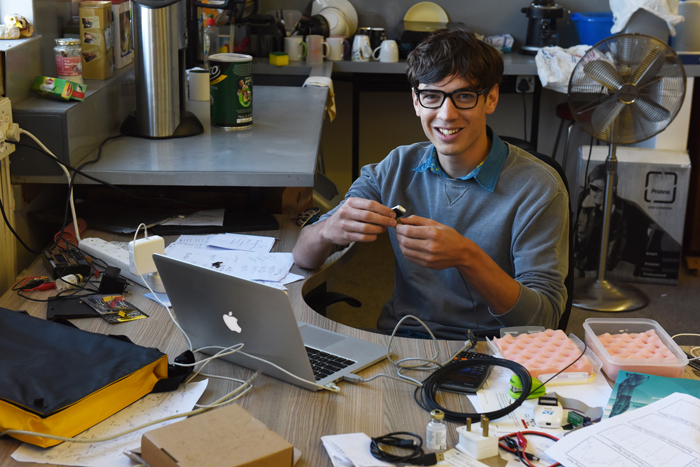Adam van Niekerk: The student inventor
07 October 2016 | Story by Newsroom
Gravity, as a force to defy and as an inspiration, has been central to Adam van Niekerk's interest in engineering and his fledgling career as an inventor.
In fact, as a child he knew what it felt like to leap over tall buildings in a single bound. Back then, a 10-year-old Van Niekerk often volunteered as the pint-sized pilot for the projects he dreamed up with his older brother and father (both of whom are engineers).
“At that time my father was working for The Hamilton Airship Company on a helium airship that the South African military was creating,” remembers Van Niekerk. “At the end of the project, my dad had some helium and sail cloth left over and so of course we decided to build our own balloon. Since I was the smallest and the lightest, I got to be the guinea pig. I could basically moon walk over the house and the blue gum trees that surrounded it. It was really fun until a wind came up and then I almost turned into a kite.”
Perhaps not the most traditional approach to instilling a love of scientific experimentation in your children, but in Van Niekerk's case, it was certainly a successful one.
A start in engineering
After finishing his matric in Pretoria, he headed straight to UCT where he thought he had been accepted to study mechatronics. When he arrived, however, he found he was actually registered for electro-mechanical engineering.
“I didn't mind,” he says. “As long as it was engineering and I got to make stuff, I was happy.”
Once he had completed his undergraduate studies, he became interested in human anatomy and decided to pursue an MSc in biomedical engineering. It was in the early months of his master's degree that he had an epiphany that once again involved gravity.
“At the beginning of the course, we had some introductory lectures, one of which was about radiology. I was immediately fascinated with MRI brain scanning, which allows for the most amazing contrasts to be gathered. However, MRI scans are very easily impacted by even small movements since the signal variants are so small and the noise created by movement is many orders of magnitude greater. It was then that I realised that between the strong magnetic field of the scanner itself and gravity, I had two unchanging vectors that could be used to calculate movement.”
The other piece of the puzzle fell into place when Van Niekerk realised that new, but already existing, technology, such as the angular-rate sensors and accelerometers found in most cellphones, were created from tiny components that were made out of silica. This meant that they were perfectly suited to be used within the powerful magnetic field of an MRI scanner.
but it is a pretty unpleasant experience for them.
So knowing that I might be able to help
is a really good feeling.”
The result? A device that uses vector observations for high temporal resolution motion correction in MRI scans. Or, in other words, a tiny, relatively inexpensive device that allows for motion detection and correction during an MRI scan.
How it all works
Van Niekerk explains that to correctly “draw” movement in 3D space requires a continuous number system with four parts that allow all rotations in space to be accurately described.
“That system is complex, but the device as a whole is relatively simple. Everything happens in real time and I actually only have to use a microcontroller, which has just a tiny fraction of the processing power of a cellphone,” he says.
Van Niekerk's device will not only allow for more accurate scanning of patients who find it difficult to remain still, such as children. It may also have applications within cardiology as a means to create accurate cardiograms and as a way of testing the health of arteries.
“There are a lot of kids that need to have an MRI, but it is a pretty unpleasant experience for them. So knowing that I might be able to help is a really good feeling,” he says.
At the end of last year, Van Niekerk converted his MSc to a PhD, which he hopes to complete by mid-2017. He is also looking into the viability of commercialising his device.
“It's great to be able to do these things at the same time,” he says, “but in the future all I really want is a workshop and some problems that need solving.”
Story Ambre Nicolson. Photo Michael Hammond.
Watch the video:
Impact through Innovation: Adam Van Niekerk
 This work is licensed under a Creative Commons Attribution-NoDerivatives 4.0 International License.
This work is licensed under a Creative Commons Attribution-NoDerivatives 4.0 International License.
Please view the republishing articles page for more information.










